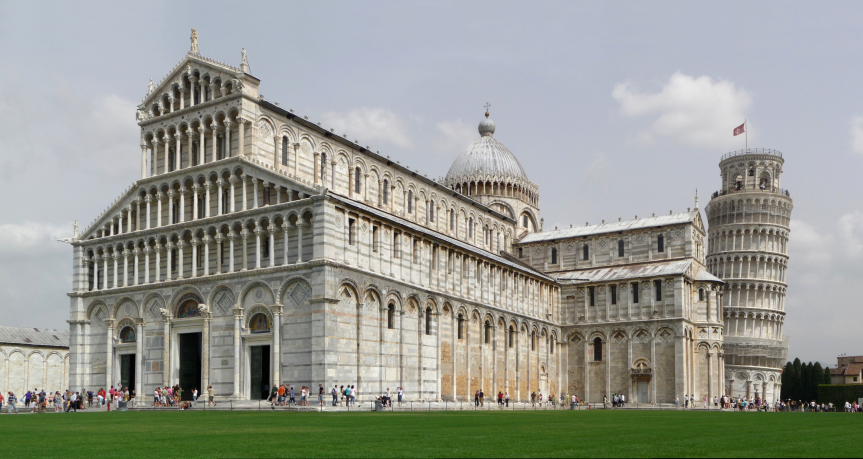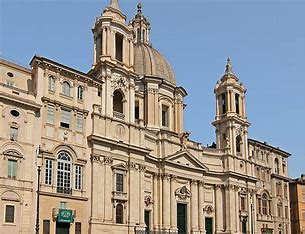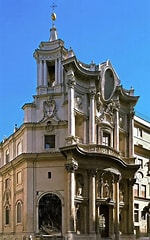HOA FINALS
1/87
Earn XP
Description and Tags
Name | Mastery | Learn | Test | Matching | Spaced |
|---|
No study sessions yet.
88 Terms
Flying Buttress
an inclined bar of masonry carried on segmental arch and transmitting an outward and downward thrust from the roof or vault to a solid buttress directing to the ground
Crocket
a hooked shaped decorative element common in gothic cathedrals.It is in the form of stylized carving or curled leaves
Finial
an ornament at the tip of pinnacle spire or other tapering vertical
Pinnacle
a pointed termination of a spire buttress or other extremity of a building sometimes decorated
Niche
a recess in the thickness of a wall
Rose Window
circular window composed of patterned tracery arranged in petal-like formation
Trumeau
a vertical architectural member between the leaves of a doorway,often highly decorated
Lancet Arch
tall thin arches like medieval lances usually paired or in triplets
Flamboyant Arch
arches that create a rich and lively effect
Lintel
transfer weight to the wall but to a series of columns,thus opening the wall and freeing the plan
East and West
The Roman Empire was halved into
Frankish King Charlemagne
established the Holy Roman Empire
sober and dignified
The general character of the Romanesque style is
rib and panel vaulting
Roman cross-vaults were gradually superseded by
Romanesque churches
Towers, either square, octagonal, or circular, are prominent features of most
pilaster strips
Walls were often built with ———- connected at the top by bands of horizontal moldings or by a series of semicircular arches
Rose or wheel window
was often placed over the west door
Pisa Cathedral

Francesco Borromini
What fatrmous baroque architect designed the church of San Carlo alle Quattro Fontane In Rome
Irregularly Shaped Pearl
The term “Baroque” is believed to have been derived from the Protuguese word “barroco”. What is the literal English translation of “barroco”?
Cupola
In Baroque Architecture, What is the name foe decorative structure that typically surmounts the dome of a building
Gian Lorenzo Bernini
Who was the famous italian architect who known for his contribution to baroque architecture including the design of the st. peter’s Baldacin in the Vatican
St. Peter’s Basilica
What Baroque church is located in Rome and is Famous for its striking designed by Michelangelo
St. Agnese In Agone

Palais De Versailles or The Palace of Versailles
Which Famous palace in france, known for its Hall of Mirrors, is considered a prime example of Baroque Architecture
San Carlo Alle Quattro Fontane

Palais de Versailes

Barrel Vault
A simplest form of a vault, consisting of a continous surface of semi circular or pointed sections
Groin Vault
A double/cross vault produced by the intersection at right angles by two barrel vaults
Semicircular Arch
The arch type utilized during the romanesque period adopted from the classical roman
Cushion Capital
a simple cube-like capital with its bottom corner tapered
Buttress
An architectural structure built against or projecting from a wall which serves to support or reinforce the wall
Romanesque
Which of the following refers to a style that developed from 800-1100 AD, and is rooted fromthe classical Romann Architecture, use of roman style, construction techniques, and ornamentatios
Christianity
It became the unifying force which influenced the developed of church architecture throughout europe especially on countries that were under roman empire
Feudalism
A system wherein most lands were owned by lords, and in order to keep their lands and personal interest, they develop a means of protection against other lords which led to the development of military architecture
Crusades
These were a series of regiously sanctioned military campaigns waged by western christian europe with the objective of restoring christian control over the holy land
There were long trips to visit the relics of saints which allowed for the exchange of ideas, including those of architecture and construction during the romanesque period
The architectural character of romanesque period can be generally describe as
What is the prevailing church plan configuration of romanesque architecture
monastic churches
Which of the following refers to a major seat of learning where members of certain orders stay and learn all sorts of arts
Narthex
The entrance or lobby area, located at the far end from the church’s main altar
transept
An area seat crosswise to the nave in a cruciform (cross shaped) building normally with breadth same as the nave
Nave
The central approach to the high altar, the main body of church
Apse
The semi- circular or polygonal termination to the choir or aisles of a church: also where =the altar is placed
f
Originally used for procession during early Christian and byzantine. it is a continuation of the aisled spaces on top
clerestory
area of windows opening outside
Castle
: in response to the political unrest of the 10th-11th centuries
Crusades
series of religiously sanctioned military campaigns that freed the Holy Places in Palestine from Islam
Pilgrimage
long trips to visit the relics of Saints
Romanesque Structures
Architectural Examples
• Pisa Cathedral, Baptistery, and Campanile • Abbey of Saint-Denis, Paris
• Basilica of Saint Sernin, Toulouse
• Notre Dame du Port
• San Miniato, al Monte
• Peterborough Cathedral
Feudal system
landlords ruled with tyranny
Goths
sometimes “barbarians” were a people who flourished in Europe into the Middle Ages.
Giorgio Vasari
referred to the Gothic style as the "barbarous German style", and blamed the Goths for several architectural features
Gothic Structures
Architectural Examples ▪ Notre Dame, Paris
▪ Chartres Cathedral
▪ Salisbury Cathedral
▪ S. Maria del Fiore
Age of Humanism
earthly fulfillment rather than a preparation for paradise and the architect followed a literary idea and theory in addition to building structures
Vitruvius in 1486
Development of the “Treatise on Architecture” by
Martin Luther
began the Protestant Reformation
Pope Sixtus V
prioritize the technology of ancient Rome, restoring ancient aqueducts and creating fake facades
Domenico Fontana
: served as the architect to Pope Sixtus V during his urban development projects in Rome
Printing Press
by Guttenburg enabling architects in other European countries to acquire copies of treaties
Linear Perspective
: Brunelleschi codified the principles of linear perspective, making an exact representation of a 3D object
Early Renaissance
: the period of learning, designers were intent on the accurate transcription of Roman elements
High Renaissance or Proto-Baroque
: became an individual style in its own right and first appeared in Rome in the work of Bramante
Purist or Palladian
: Roman traditions
Proto-Baroque
– more confidence in acquired vocabulary freely
Baroque
: characterized as being dramatic, rich, grand, and alive
talian Mannerism
I: characterized by exaggerated, elongated proportions of figures
Loggia delle Muse:
the muses of Logia
Sala di Amore e Psiche:
Cupid and Psyche’s Hall
Sala dei Giganti
: the Giant’s Room
Pallazzo
“palace,” a governmental, institutional facility, and private residence
Piazza
public square
Rotunda
private residence
Vestibolo
entrance hall that leads from the street to the courtyard
Cortile
Italian word for courtyard.
Sala
Italian word for “room.” Salone; big room
scala
staircase, scalone; grand staircase
Camera
chamber
Studiolo
small study
Piano Terra
Ground floor
Primo piano nobile
main reception and bedrooms of the house. First floor
Secondo Piano Nobile
Second floor
Quion
corners of walls
Rustication
a stone that is cut and carved
Spain
a plateresque style, comes from the Spanish word “Platero” meaning silversmith
Portugal
a Manueline style, named after King Manuel I, is decorative rather than structural and is inspired by the voyages of discoverers
Germany
marked by a blending of traditional German Gothic elements with emerging Renaissance design principles.
Renaissance Structures
Florence Cathedral: The cathedral of St. Maria del Fiore by Filippo Brunelleschi
▪ Tempietto in S. Pietro, Montorio: temple by Donato Bramante
▪ San Biagio, Montepulciano: An example of a Renaissance Greek cross central plan by Antonio da Sangallo
▪ Palazzo del Te: a masterpiece of the Late Renaissance by Giulio Romano
▪ St. Peter’s Basilica, Rome: a combination of Renaissance and Baroque styles by Bramante, Michelangelo, Carlo Moderno, Bernini
▪ St. Gervais, Paris: earliest example of Renaissance Architecture with a classical church facade by Salomon De Brosse
▪ Palazzo Medici Riccardi in Florence: by Leon Battista Alberti known for its innovative use of rustication